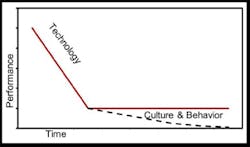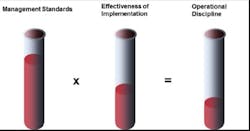Orchestrate an Effective Safety Culture
Many chemical manufacturers are doing excellent work to identify hazards and reinforce safe behaviors. Unfortunately, after a time, safety performance often levels off and improvement seems to reach a plateau.
There are several reasons for this. Traditionally, companies have looked to technology to solve the issues associated with hazardous processes. Yet experience indicates technology by itself isn't a panacea for all problems. A manufacturer can invest significantly in the latest technologies and control systems but whether these work effectively will depend upon manager, supervisor and worker behavior (Figure 1).
So, as a chemical engineer with operations background, I'd like to share some insights on how to successfully achieve an effective safety culture.
FACTORS IMPACTING SAFETY CULTURE
A company's culture encompasses everything it does, including safety — it's a mindset and a way of being. At the heart of safety culture is process safety, an ethical imperative that calls for all manufacturers to do their utmost to keep employees, partners and surrounding communities safe.
Success in operations usually is quantified in terms of capacity utilization, prevention of unplanned shutdowns and managing operating costs. Some sites — mistakenly — treat the number of personal safety incidents as a measure of process safety ("Safety Statistics Can Get You Into a Scrape"). Much less attention is paid to culture as a measure of success and the influence of culture on performance knowledge retention and operational sustainability.
In general, chemical engineers fully understand that safety and production are inseparable. Yet, we continue to hear about avoidable process incidents that have occurred because production took priority over safety. When we read the investigation reports, we ask ourselves: "Why would anyone do that?" or "What in the world was the business thinking?" However, we often don't recognize similar mistakes we make that could result in incidents.
Many companies rely on a process hazards analysis (PHA) done at the site construction and commissioning stage. The operating organization usually doesn't have access to the results of the PHA and the original analysis never is reviewed. The consequence is a lack of knowledge across the operating and maintenance groups about correct safety procedures. This can cause major incidents.
For example, I know of one manufacturer with high risk operations that limited process safety information and the PHA to select individuals. There was no broad communication beyond standard operating procedures (SOPs). Operators were told to do as instructed; they didn't question why or understand the consequences of not following procedures. They had scant knowledge about what to do in case of abnormal or emergency conditions. Because the operators were deemed to have inadequate technical and process knowledge, they also had little empowerment in decision-making. As a result, an event that could have been contained developed into a major incident. Situations like this point up the need to demystify process safety management (PSM) to create a learning organization with a high level of awareness across the company.
NORMALIZATION OF DEVIATIONS
Another factor that contributes to safety incidents is what has been called "normalization of deviations." This usually occurs when what begins as a one-time or temporary departure from prescribed procedure fails to result in negative consequences and, thus, becomes accepted practice.
Consider this process example: A pressure relief device was leaking a flammable material. A replacement wasn't available immediately, so, to avoid leakage, someone closed the manual valve leading to the relief device. The process continued to run with the manual valve in a closed position. Because this temporary solution appeared successful, it became a normal practice. However, one day a pressure buildup occurred — because the pressure relief device wasn't available, there was an explosion. This case illustrates that a culture tolerating serious and long-standing deviations from good safety practice can result in the normalizing of deviations. (For other examples, see "Work on Workarounds." )
Analysis of catastrophic incidents often indicates that numerous warning signals were missed prior to the incident. Many companies tend to downplay minor leaks or small fires and not evaluate them from a worst-case-scenario standpoint. This practice is a serious mistake and can become catastrophic when the same or similar incidents occur repeatedly (Figure 2).
However, warning signs may not always appear before a catastrophic incident. For example, a small leak of a flammable material can instantaneously produce an explosion, depending on the location and proximity to sources of ignition.
Chemical makers, by failing to take sufficient notice of unsafe acts and conditions as well as near misses, are losing opportunities to learn from minor incidents to prevent potential major or catastrophic events — and to create a learning organization that gains knowledge from its experience.
First, companies must appreciate that process safety information and PHAs are the foundation of effective PSM. PHA results will drive the design and implementation of the rest of the process safety requirements — SOPs and safe work practices; mechanical integrity and quality assurance; training of personnel including contractors; changes in technology, facilities and personnel; and dealing with emergencies (Figure 3).
This process addresses the fundamental "why" questions: Why is there an SOP? Why is equipment classified as process critical? Why can't a process temperature or pressure exceed a particular value? Why is there a need to conduct drills to prepare for specific types of emergencies? Asking why by itself is a way of demystifying PSM.
To further demystify PSM, DuPont follows some best practices that have helped improve and sustain good performance. For a start, we recruit an operations team at the project stage, so it can acquire familiarity with the results of the process safety information and PHA. The operations team studies the results of the PHA and develops the SOPs. In fact, the PHA results form the basis for designing the PSM system. In addition, for a high hazard operation, the PHA is reviewed every three years — the operating and maintenance teams always are engaged in this process to ensure ownership and reinforce the importance of following procedures.
Each of our plants also has a permanent PSM committee whose members represent various levels of the operating organization. Depending upon the number of personnel on the site and whether it houses a high hazard operation, subcommittees or champions may act as custodians of process-safety-program elements and report to the committee. Operators and technicians serve on subcommittees or as champions, ensuring operators' needs are considered when procedures are defined. Through a series of checks and balances — including periodic reviews, operator certification, job cycle checks and audits — all relevant personnel understand what they need to do and why it's important.
To illustrate the need for operational discipline, let's look at what happened at a trucking company that, for quality control, collected daily samples from almost 300 vehicles. The sampling required operators to climb every truck, exposing them to a falling hazard. Someone suggested that building a platform with railings would make gathering the samples easier and safer. Company leaders agreed and approved the resources to build the platform, which was inaugurated with a lot of fanfare plus an award to the person who had made the suggestion. Unfortunately, this isn't the end of the story. A week later, observers noticed the platform wasn't being used and the old way of sampling continued.
It's often assumed people automatically will follow any new procedure that reduces risk and improves safety. In reality, implementing any change requires supervision and a consistent and focused effort. This includes coaching and guidance beyond the confines of a classroom. It also demands continuous enforcement through both positive and negative measures to ensure employees really adhere to the change. This is where the role of management and supervision becomes critical in enforcing the expected standards every time to achieve and sustain a high level of operational discipline.
COLLABORATIVE LEARNING
To understand risk potential and the importance of constant vigilance, chemical manufacturers must develop a learning culture. This requires reporting of incidents, investigating their potential consequences, and then sharing the learnings from the investigation with all relevant personnel. At DuPont, this is a well-accepted and ingrained practice. The company works continually to maintain an environment conducive to reporting, one not based on blame; in fact, we treat failure to report incidents as an ethical violation.
To create such an environment, company leaders must clearly encourage reporting of incidents and disseminating learnings to prevent recurrence. Studying incidents that have occurred at other organizations can provide further insights. Line management also must take responsibility through personal involvement in the learning management process.
Another way to build and maintain a culture of reporting and learning is through positive reinforcement of superior safety performance. A recognized process for identifying and rewarding individuals who report incidents and share information can help prevent new incidents. This is more effective than punishing or assigning blame without proper investigation. The message conveyed — that the company holds safety and safe employees in high regard — is more important than the size or type of recognition.
A strong process safety culture helps reduce incidents and keep employees safe, leading to a more sustainable business. Engaged leadership, the ability to demystify PSM, achieving and sustaining operating discipline, and creating a collaborative learning environment will result in organizational and operational effectiveness. Dividends include greater productivity, an improved risk profile, and higher employee morale.
RAMABHADRAN SRINIVASAN is Singapore-based global leader, process safety and risk management offerings, for DuPont Sustainable Solutions. E-mail him at [email protected].






